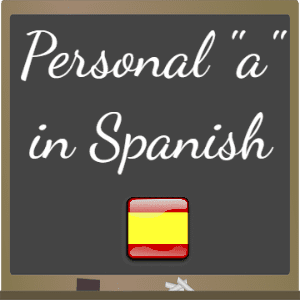Another example of grammar that has no equivalent in English is the use of the personal “a” in Spanish. The preposition “a” is used frequently in Spanish, e.g., “Voy a la escuela” (I go to school). A special use of the preposition “a” is to precede the direct object when it is a defined person or a group of defined persons. In this case, the preposition “a” is known as personal “a.”
Examples of Personal “a” in Spanish
Here are some examples of the use of personal “a” in Spanish:
| Yo vi a mi mamá ayer. | I saw my mom yesterday. |
| Él llama a su amigo frecuentemente. | He calls his friend frequently. |
| Ella visitó a sus padres anoche. | She visited her parents last night. |
| Comprendo a mi profesor fácilmente. | I understand my professor easily. |
Notice that the English translation of the above sentences has no direct equivalent of the personal “a” in Spanish.
If we refer generally, and not specifically to a person, we do not use the personal “a” in Spanish, for example:
| Yo vi dos mujeres charlando ayer. | I saw two women chatting yesterday. |
| Él necesita un médico inmediatamente. | He needs a doctor immediately. |
Personal “a” with Pets in Spanish
Generally, a pet is treated as a person in Spanish. The personal “a” is used when referring to a pet, but not with ordinary animals, for example:
| Le doy un baño a mi gato todos los meses. | I give my cat a bath every month. |
| Vi un conejo en el zoológico. | I saw a rabbit in the zoo. |
In the first sentence above, the “cat” is a pet. Thus, the personal “a” in Spanish is used. On the other hand, the “rabbit” in the second sentence is an ordinary animal that does not require the use of the personal “a.”
Personal “a” with Pronouns
Pronouns referring to a person or persons are also treated in the same way as a specific person or persons. Thus, the personal “a” is used. This includes each of the following pronouns when used as a direct object referring to people: “alguien” (somebody), “nadie” (nobody), “quien” (whom), “alguno” (some), and “ninguno” (none), for example:
| No vi a nadie ayer. | I didn’t see anybody yesterday. |
| Tengo que llamar a alguien. | I have to call someone. |
Personal “a” in Spanish with Non-Persons
If a direct object is personified to express emotion or attachment, the personal “a” can be used to imply such emotion, for example:
| Extraño mucho a mi país. | I miss my country a lot. |
| Abrazaría a la almohada como si fuera mi amiga. | I’d hug my pillow as if it were my friend. |
Personal “a” with “Haber” and “Tener”
The only verbs that generally do not use the personal “a,” even when referring to a specific person or persons, are “haber” and “tener,” for example:
| Hay 15 estudiantes en la clase. | There are 15 students in the class. |
| Tengo cinco primos. | I have five cousins. |
The only exception to the verb “tener” is when used to mean holding someone physically or emotionally close to you. In this case, the personal “a” is used, for example:
| Cuando hay un problema, tengo a mi familia. | When there is a problem, I have my family. |
| Tendré a mi hermano en los brazos. | I will have my brother in my arms. |
Quiz: Personal “a” in Spanish
Other lessons in Level IV:











